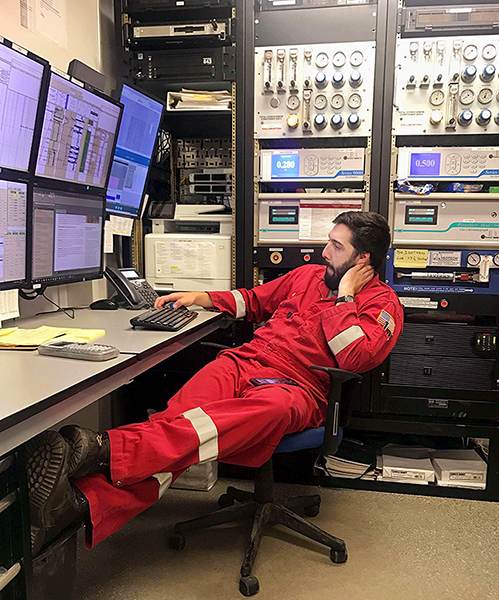From Potsdam undergraduate to deep-water oil well wrangler, geology alum is hard put to find a dull moment
Evan Smith ’12 used his geology training at SUNY Potsdam to dive deep into the world of oil and gas exploration and extraction, becoming an offshore drilling savant who leverages the latest technology to guide work in some of the richest—and riskiest—oil and gas fields on earth.
Smith’s days never lack for interest. At the head of a team of five and capable of guiding well placement operations from anywhere in the world, Smith, who works as a geosteering, geoscience, and remote operations team leader for Halliburton, focuses on ship-based drilling by Exxon Mobile in oil and gas fields off the shores of Guyana, far below the ocean’s surface.
For a driller, these fields are a paradise of opportunity—even if difficult and dangerous to access. A single 6.6-million-acre area called the Stabroek Block, 120 miles off the coast of Guyana, delivered more than 500 million barrels of oil in its first five years of production ending in 2024.
“With more than 30 discoveries in the Stabroek Block alone, it is certainly one of the most exciting offshore prospects globally in recent years,” Smith said. “One of the main challenges of the drilling directly relates to my field. Working in such a complex offshore environment requires advanced technologies to efficiently navigate and access these reservoirs. These technologies require teams of people coming together to design, develop, build, use and maintain them.”
Working as a geosteerer requires a solid understanding across a broad range of related areas. Smith must make quick, high-stakes interpretations of data from multiple streams in real time and coordinate teams to adjust the well path so that extraction stays in the optimal zone—and he gets there by combining the knowledge of diverse specialists located around the globe. Smith and his team use specialized instruments to measure the conductivity and resistivity of geology surrounding the well as it is being dug, with a goal of creating a 3D model of the earth using this imagery. Supported by other wellbore evaluation tools ranging from gamma ray to neutron porosity measurements, the technology helps Smith map the best oil sands, place the well correctly and keep it in the most productive location. That’s geosteering.
“The specialized tools, especially the azimuthal ultra-deep resistivity tools, that we use for real-time decision-making are incredibly exciting,” he said. “What excites me even more, though, is the collaboration with people from all over the world. Each team member brings unique experiences and expertise, and geological interpretation becomes our shared language.”
Evan’s time in the Department of Geology (now Earth and Environmental Sciences) at Potsdam laid the bedrock for everything he has been able to do in his career. Rather than being lost in the crowd, he found in Potsdam a right-sized program with a lot of personal attention, and he grew to know his professors and fellow students well.
“I think the course that stood out the most surrounded the geology of Nova Scotia, which was a field-based summer course where we traveled around Nova Scotia examining outcrops,” Smith remembered. “I still have some samples from that trip sitting on my work desk. The course was my first taste of prolonged fieldwork and helped solidify my passion for the field.”
Post-graduation, Smith’s first five years at Halliburton were spent identifying and describing geological cuttings that came up from the wells—a process called mudlogging. A core understanding of the Earth and what he was seeing—built in Potsdam—was invaluable. Those fundamentals continued to serve Smith when he moved into geosteering, which requires a much more refined level of geological interpretation.
Smith plans to keep learning and growing, and he has a lot of ground to cover and explore. With a goal of becoming a regional or global expert in geosteering and geomapping, he’s drawn to the application of ultra-deep electromagnetic tools to map and characterize geology at great depth to find and most efficiently extract hydrocarbon resources. His advice to geology students wanting a similar job is to strive to continuously learn, build strong relationships, and surround themselves with the right people.
“The energy industry is collaborative,” he said. “The connections you make in school and early in your career can open doors to exciting opportunities.”
Article by Bret Yager, Photos courtesy of Evan Smith

